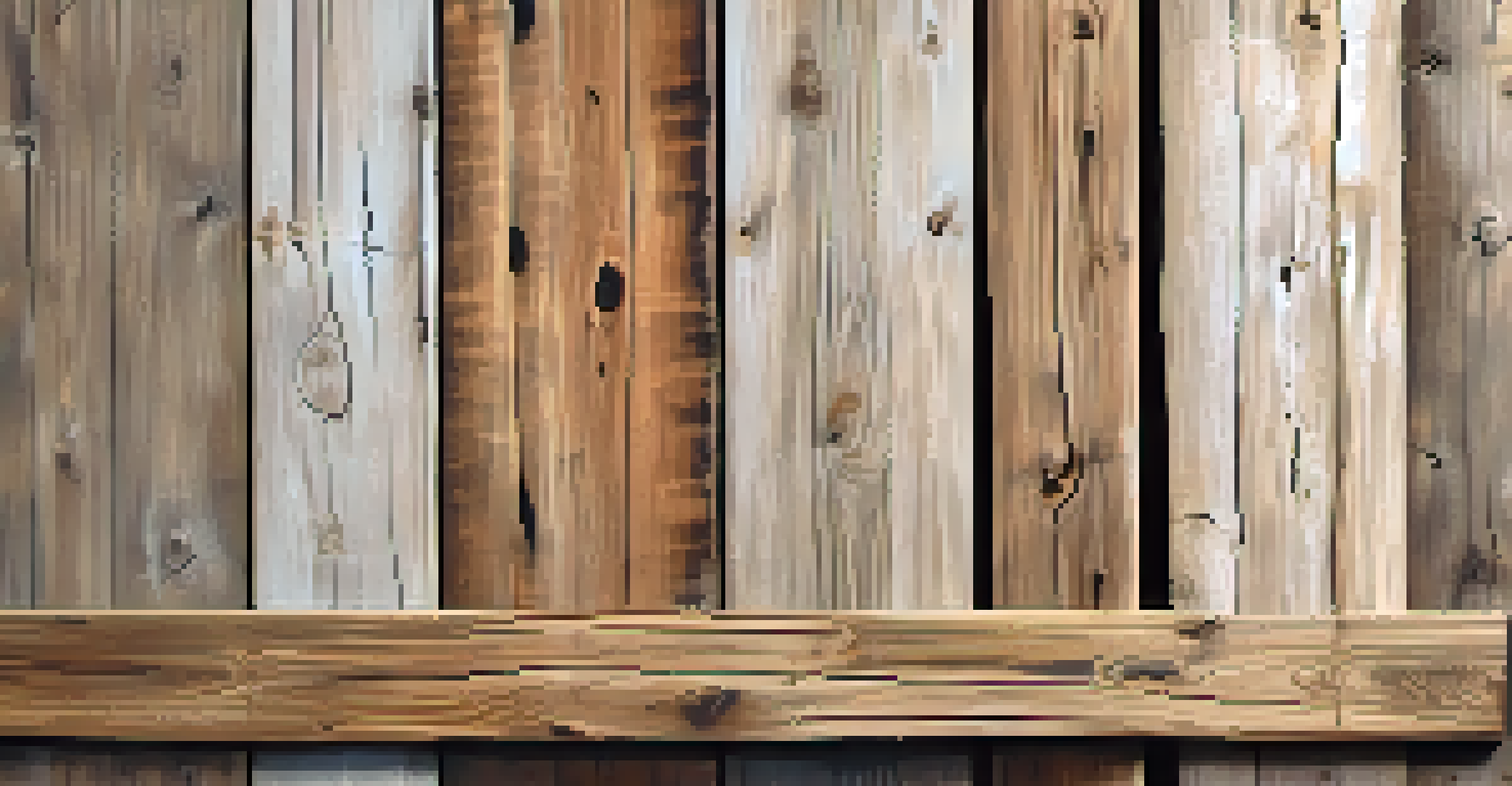The Benefits of Using Reclaimed Wood in Construction Projects

Sustainable Building: Why Reclaimed Wood Matters
Using reclaimed wood is a fantastic way to embrace sustainability in construction. By repurposing old wood, we're reducing the demand for new timber, which helps to conserve forests and the ecosystems they support. This not only lowers our carbon footprint but also supports responsible forestry practices.
The greatest threat to our planet is the belief that someone else will save it.
Imagine giving a second life to materials that might otherwise end up in a landfill. Reclaimed wood can come from various sources, such as old barns, factories, or even shipping pallets, allowing us to keep valuable resources in circulation. This practice aligns perfectly with eco-friendly construction trends, making it a popular choice among environmentally conscious builders.
Moreover, choosing reclaimed wood sends a powerful message about your commitment to sustainability. It resonates with clients and communities who value responsible building practices, enhancing your brand's reputation while making a positive impact on the planet.
Unique Aesthetics: The Charm of Reclaimed Wood
One of the most appealing aspects of reclaimed wood is its unique aesthetic. Each piece carries its own story, showcasing a rich history through its patina, knots, and imperfections. This character adds warmth and depth to any construction project, making spaces feel more inviting and personal.

Think about how a rustic barn wood accent wall can transform a modern home into a cozy retreat. The contrast between old and new creates a visually intriguing environment that appeals to many design sensibilities. Whether you're going for a chic industrial look or a classic farmhouse style, reclaimed wood fits seamlessly into a variety of themes.
Sustainability through Reclaimed Wood
Using reclaimed wood reduces waste and lessens the demand for new timber, contributing to forest conservation and lowering our carbon footprint.
Additionally, reclaimed wood can be a conversation starter. Guests often admire the distinctive features, sparking stories about the wood's origins and history. Incorporating such materials not only enhances your space but also invites connections and conversations among those who experience it.
Durability: Why Reclaimed Wood Stands the Test of Time
Reclaimed wood often boasts superior durability compared to new wood, primarily because it has already endured the elements for years. As it ages, the wood becomes denser and more resistant to wear and tear, making it an excellent choice for high-traffic areas or outdoor applications.
We do not inherit the earth from our ancestors; we borrow it from our children.
For example, reclaimed wood from old barns has withstood harsh weather conditions for decades, proving its strength. This durability translates to less frequent replacements and repairs, ultimately saving you time and money in the long run. It's like investing in a classic car that only appreciates with age!
Moreover, using reclaimed wood can enhance the structural integrity of your project. Many builders find that older wood, particularly from species like oak or heart pine, offers exceptional stability and strength. This reliability means peace of mind for homeowners and contractors alike.
Cost-Effectiveness: Save Money with Reclaimed Wood
While some might assume that reclaimed wood is expensive due to its uniqueness, it can actually be a cost-effective option. Depending on the source, reclaimed wood can be more affordable than new hardwoods. Plus, the savings from reduced maintenance and replacement costs further sweeten the deal.
Imagine a construction project where you can save on materials without sacrificing quality. By choosing reclaimed wood, you're not only cutting costs but also investing in a durable product that will last for years. It's a win-win situation for budget-conscious builders.
Unique Charm of Reclaimed Materials
Reclaimed wood adds a distinct aesthetic and character to spaces, inviting connections and conversations through its rich history and imperfections.
In addition, many local suppliers offer reclaimed wood at competitive prices, making it accessible for various projects. By supporting local businesses, you also contribute to your community's economy, enhancing the overall value of your project.
Environmental Impact: Lowering Your Carbon Footprint
The environmental benefits of using reclaimed wood extend beyond sustainability. By choosing reclaimed materials, you're actively reducing waste and minimizing the need for new resources. This helps lower the overall carbon footprint of construction projects, which is vital in combating climate change.
Every piece of reclaimed wood used is one less tree cut down, and one less truckload of waste headed for landfills. Imagine the collective impact if more builders made this switch—it's a small change with a significant effect on our planet's health.
Furthermore, many reclaimed wood suppliers focus on environmentally friendly practices, ensuring that their products are sourced responsibly. When you choose reclaimed wood, you're not just making a design choice; you're making a statement about your values and commitment to a healthier planet.
Versatility: Reclaimed Wood for Every Application
Reclaimed wood is incredibly versatile, making it suitable for a wide range of construction applications. From flooring and cabinetry to beams and outdoor decks, the possibilities are virtually endless. This adaptability allows builders to get creative while maintaining a consistent aesthetic throughout a project.
For instance, a restaurant could use reclaimed wood for both its bar tops and wall paneling, creating a cohesive look that feels warm and inviting. Similarly, homeowners can incorporate reclaimed wood into their interiors, from kitchen islands to accent pieces, enhancing the overall design.
Cost-Effective and Durable Solution
Reclaimed wood can be more affordable than new hardwoods and offers superior durability, leading to long-term savings on maintenance and replacements.
Additionally, reclaimed wood can be used in both residential and commercial settings. Whether you're designing a cozy cabin or a sleek office space, this material can elevate any environment. Its ability to blend with various styles makes it a favorite among architects and designers alike.
Historical Value: Connecting with the Past
Using reclaimed wood in construction allows us to connect with history in a tangible way. Each piece has its own narrative, whether it’s salvaged from an old schoolhouse or a century-old barn. This history adds depth and character to spaces that new materials simply can't replicate.
Imagine walking into a home with reclaimed wood beams sourced from a local church built in the 1800s. The stories embedded in that wood create a unique atmosphere that fosters a sense of nostalgia and belonging. People often feel more connected to spaces that have a rich history, enhancing their overall experience.

Moreover, incorporating reclaimed wood can preserve a piece of local heritage. By using materials that reflect the community's past, builders help maintain cultural identity while creating beautiful, functional spaces. It’s a beautiful way to honor tradition while moving forward.